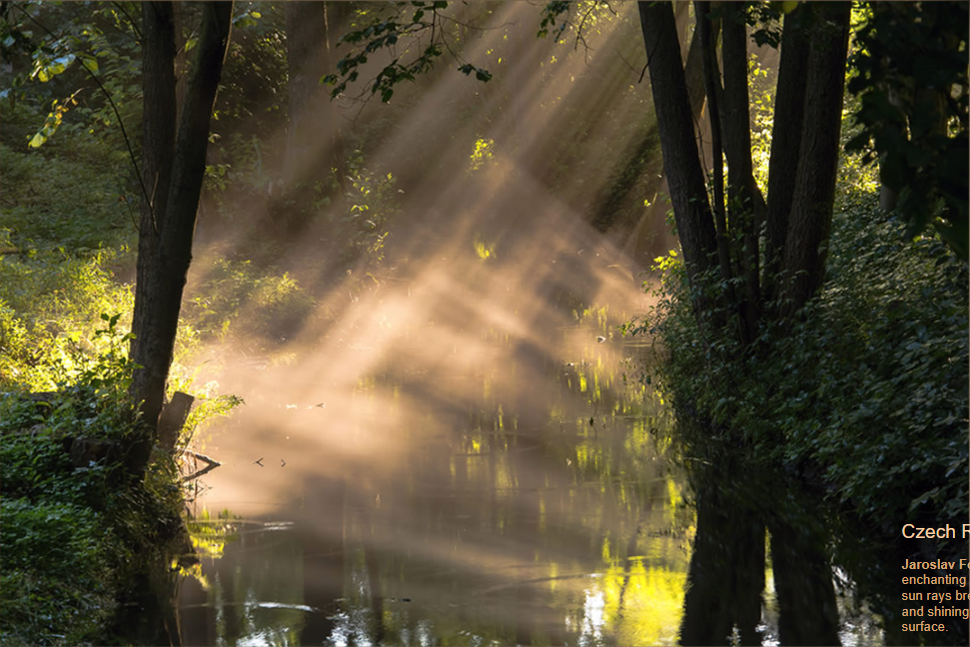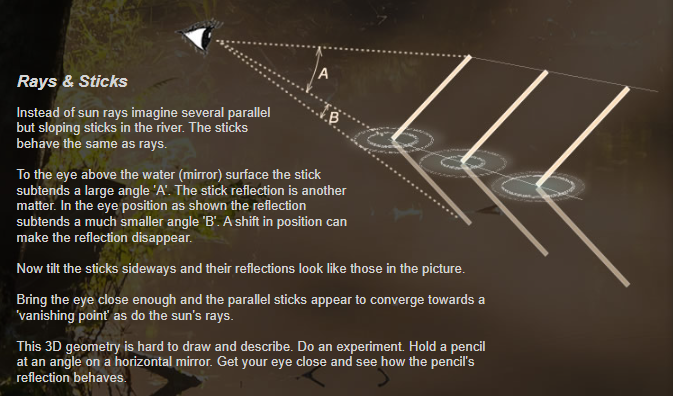River reflected crepuscular rays, a puzzle - OPOD
River Reflected Crepuscular Rays: A Puzzling Phenomenon
Crepuscular rays, also known as sunbeams, are a captivating atmospheric optical phenomenon that occurs when sunlight shines through gaps in clouds or objects. These rays appear to converge towards the point in the sky where the sun is located. However, there is a fascinating twist to this phenomenon when it comes to reflected crepuscular rays on a river's surface.
When the sun's rays break through the trees and illuminate the smooth surface of a river, some of the rays are reflected back upwards from the water. In this enchanting morning scene captured by Jaroslav Fous, we can see both the downward sun rays formed by gaps in the trees and the upward rays reflected from the river surface.
But here's where the puzzle begins. The reflected rays on the river's surface create mirror images of the actual rays. Distinguishing between the real reflected rays and their mirror images becomes a challenge, as they have different angles than what we would expect. The mirror images have shallower slopes compared to the incident rays, leading to a contradiction in our understanding of reflection laws.
To understand this phenomenon better, let's imagine several parallel sticks sloping in the river instead of sun rays. These sticks behave in the same way as rays of light. When viewed from above the water's surface (like looking into a mirror), the stick appears to subtend a large angle 'A.' However, when we observe the stick's reflection from the same eye position, the subtended angle 'B' is much smaller. By shifting our position, we can even make the reflection disappear.
Now, if we tilt these sticks sideways, their reflections on the river's surface resemble what we see in the picture. When we bring our eye close to the surface, we notice that the parallel sticks appear to converge towards a "vanishing point," just like the sun's rays. This 3D geometry is challenging to describe and draw accurately, but you can conduct a simple experiment to experience it firsthand. Hold a pencil at an angle on a horizontal mirror and observe how its reflection behaves as you bring your eye closer.
The apparent contradiction in the angles of the reflected crepuscular rays arises from our expectation that reflections in a mirror should look the same as the real object, except for being flipped. However, when it comes to reflections on the surface of a river, they do not conform to this expectation. The mirror images of the rays have different slopes compared to the actual rays.
The interplay between the real rays, their mirror images, and the perspective effects created by the river's surface adds to the complexity of this optical puzzle. While the reflection laws are not violated, our perception of how reflections should appear in a mirror leads us to question why they differ in this scenario.
In conclusion, river reflected crepuscular rays present a fascinating puzzle in atmospheric optics. The combination of real rays, mirror images, and perspective effects on the river's surface creates a mesmerizing scene that challenges our understanding of reflection laws. Exploring this phenomenon through experiments and observations can deepen our appreciation for the intricacies of light and its interaction with the natural world.

Czech River Rays
Jaroslav Fous caught this enchanting morning scene of sun rays breaking through trees and shining on a smooth river surface.
Some rays are reflected back upwards from the water, there are also mirror images.
But which are which? Why are their angles not what you would expect?
Image ©Jaroslav Fous, shown with permission

The scene has downward sun rays formed by gaps in trees and upward rays reflected from the river surface.
Both are corporeal, they exist in real space, they can be touched, walked around, they show perspective effects.
As a complication the surface forms virtual mirror images of all these!
The ‘real’ reflected rays are hard to separate from the mirror images and they have shallower slopes. Surely a mirror should produce rays with the same slopes as the incident rays? “The angles of incidence and reflection are the same” – we are told.
There is no violation of reflection laws. The apparent contradiction arises from our expectation that reflections in a mirror look the same (except for being flipped) as the real object.
They do not.

Rays & Sticks
Instead of sun rays imagine several parallel but sloping sticks in the river. The sticks behave the same as rays.
To the eye above the water (mirror) surface the stick subtends a large angle 'A'. The stick reflection is another matter. In the eye position as shown the reflection subtends a much smaller angle 'B'. A shift in position can make the reflection disappear.
Now tilt the sticks sideways and their reflections look like those in the picture.
Bring the eye close enough and the parallel sticks appear to converge towards a 'vanishing point' as do the sun's rays.
This 3D geometry is hard to draw and describe. Do an experiment. Hold a pencil at an angle on a horizontal mirror. Get your eye close and see how the pencil's reflection behaves.
Note: this article has been automatically converted from the old site and may not appear as intended. You can find the original article here.
Reference Atmospheric Optics
If you use any of the definitions, information, or data presented on Atmospheric Optics, please copy the link or reference below to properly credit us as the reference source. Thank you!
-
<a href="https://atoptics.co.uk/blog/river-reflected-crepuscular-rays-a-puzzle-opod/">River reflected crepuscular rays, a puzzle - OPOD</a>
-
"River reflected crepuscular rays, a puzzle - OPOD". Atmospheric Optics. Accessed on December 18, 2024. https://atoptics.co.uk/blog/river-reflected-crepuscular-rays-a-puzzle-opod/.
-
"River reflected crepuscular rays, a puzzle - OPOD". Atmospheric Optics, https://atoptics.co.uk/blog/river-reflected-crepuscular-rays-a-puzzle-opod/. Accessed 18 December, 2024
-
River reflected crepuscular rays, a puzzle - OPOD. Atmospheric Optics. Retrieved from https://atoptics.co.uk/blog/river-reflected-crepuscular-rays-a-puzzle-opod/.